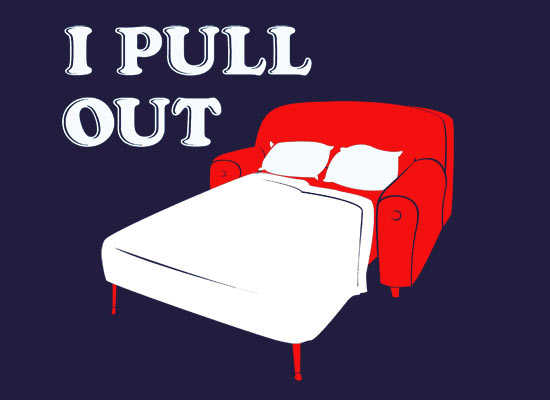The 9 Weirdest Facts About Boobs
Society’s continuous fascination with breasts has led to a bunch of quirky scientific studies over time with some wacky findings you wouldn’t believe…
Boobs…we can never quite seem to get enough of them or stop talking about their appearance. Indeed, there are countless studies dedicated to unearthing the mystery of their enchanting allure, with some research providing particularly comical insight into our perception of breasts and personal preferences. While the legitimacy of many of these so-called “scientific findings” is questionable, here is a list of the weirdest boob studies out there worthy of mention:
1. Poor men like big breasts while financially secure men prefer smaller breasts.
Busty women beware: your cleavage may be attracting gold diggers. According to Psychology Today, the amount of money a man earns has a lot to do with the size of breasts he prefers. The study, conducted by two psychologists, set out to explore the link between financial security and men’s breast size preferences. Men from different socio-economic backgrounds – 266 to be exact – were asked which breast size they found more sexually attractive based on a series of animated female figures with various breast sizes.
The study determined that poorer men or men experiencing “resource insecurity” preferred larger breasts while those who were financially well off preferred smaller boobs. Moreover, it suggests that one view on women’s breast size is that it acts as a “signal of fat reserves, which in turn advertises access to resources”.
2. Hungry men desire big breasts while satiated men prefer a smaller chest.
In a second experiment following on from the previous study, the aim was to determine whether “food security” played a role in preferences of breast size. Researchers found that hungry men preferred larger breasts to those whose stomachs were full. The results were compiled by comparing the breast size ratings of 66 hungry men vs. 58 satiated men – all white British men from a male university dining hall during dinner.
Only white British men were invited to participate in the experiment because of the fact that ethnicity is known to influence breast size preferences and the study wanted to eliminate any additional factors, which may affect the outcome. The study resulted in a finding that hungry men substantially preferred fuller-breasted women. Bon appétit indeed!
3. Men not interested in fatherhood find large breasts less attractive
According to Psychology Today, researchers Christopher Burris and Armand Munteanu conducted a study based on an “evolutionary perspective on breast size,” by asking 67 college men about their desire to become a father. Their answers were measured on a scale. Thereafter, the men were asked to adjust women’s’ breasts, hips and proportions on a computer-animated program according to their “ideal sexual partner”. The results revealed that men who wished to remain childless preferred smaller breasts, while men who preferred larger breasts had a desire to become a dad.
The study maintains that large breasts are innately a signal of woman’s capacity and ability to bear and nurture children. Key findings suggest there is an association between a particular fertility-related hormone and larger breast tissue. Furthermore, a link was found between larger breasts and a smaller waste-to-hip ratio with regards to the greater likelihood of conceiving children.
4. Squeezing breasts may prevent cancer
Good news for men – you may actually be saving the life of your significant other by continuously grabbing her breasts. According to the UC Berkeley and Lawrence Berkeley National Laboratory, squeezing breasts can prevent cancer. Apparently mechanical forces and applying physical pressure on the breasts can stop the rapid growth of cancer and prevent out of control cells from turning malignant.
Gautham Venugopalan, from the UC Berkeley Fletcher lab, explained that people have known for centuries that physical forces can influence the body: “When we lift weights, our muscles get bigger. The force of gravity is essential to keeping our bones strong. Here we show that physical force can play a role in the growth — and reversion — of cancer cells,” he told the UC Berkeley News Centre.
5. Women who get breast implants are three times more likely to commit suicide
According to the American Society of Plastic Surgeons, breast implants are now the number one cosmetic procedure in the United States. How ironic is it then that a procedure that is undertaken to supposedly enhance a woman’s self-esteem, has resulted in a finding that women who get breast implants are at least three times more likely to commit suicide.
The 2007 Annals of Plastic Surgery report found that the increased risk of suicide became apparent 10 years after a woman received implants. Loren Lipworth of the Vanderbilt University Medical Center monitored 3,527 Swedish women who had undergone breast enhancement surgery between 1965 and 1993 finding that while only 24 of the women had committed suicide after an average of 19 years, the risk of suicide in this group tripled in comparison to the average population. The study also acknowledged that such suicides could have been attributable to pre-existing psychiatric problems, which made some women prone to suicidal behavior.
6. Sexist men prefer large breasts
According to a study from the University of Westminster, men who exhibit sexist attitudes towards women are also likely to have a preference for large breasts. The findings, which show a connection between sexism in men and breast size, involved 361 white men from 18-68 years of age being shown 3D models of women with a range of breast sizes. The men were then asked to identify which women they found most attractive following which each was given a survey measuring hostility and attitudes toward women, relationships, benevolent sexism and how much a man objectified a women.
The research found that the largest percentage of men (32.7 per cent) rated medium-sized breasts “most attractive”, followed by large (24.4 per cent) and then very large breasts (19.1 percent). The majority of men interested in large to very large breasts admitted to displaying behavioral traits of sexism and hostile attitudes towards women.
The study concluded that men perceive large breasts as “traditional” femininity and “perceive women as meek and weak”. The researchers of the study said, “it is arguable that benevolently sexist men perceived larger female breasts as attractive because larger breast size on a woman is associated with perceived femininity”, as reported by Huffington Post.
7. Bras accelerate sagging
According to a French study conducted over 15 years on women aged between 18-35, wearing a bra is completely useless for women and may actually cause more harm than good. The study claimed that those women who did not wear a bra actually benefited long term, as they were able to develop more muscle tissue, which provided natural support.
Professor Jean-Denis Rouillon who conducted the study said that nipples gained “a higher lift in relation to the shoulders” on women who did not wear a bra. The study suggests that when bras are worn, the restrictive material prevents such tissue from growing, which may actually accelerate sagging.
Professor Rouillon told Connexion: “Medically, physiologically, anatomically – breasts gain no benefit from being denied gravity. On the contrary, they get saggier with a bra,” he said.
Interestingly, the study did not indicate the actual breast size of the women who were involved in the experiment.
8. Men who like small breasts prefer a submissive partner
According to psychologist, Stuart Fischoff,. Ph.D., men who like women with small breasts are generally seeking a more submissive, non-threatening partner. He explained in Men’s Health:
“You may get the psychological hint that she’s not trying to compete with other women who have larger breasts, and therefore she’ll be loyal to you. Or maybe the very first girl you had a crush on had small breasts, and if she constructed your earliest example of what’s sexy, her memory may still lead you to find small-breasted women exciting,” he said.
9. Staring at boobs extends a man’s life by five years
A German study, which has been circulating around the internet for years, claims that staring at women’s’ breasts for ten minutes a day will prolong a man’s life by five years. According to the “author”, Dr. Katren Weatherby, staring at breasts for ten minutes a day is said to be equal to 30 minutes of aerobic exercise.
The study supposedly involved a team of investigators visiting three hospitals in Frankfurt, Germany, and comparing the health of 200 males over a period of five years. Half were asked to stare at busty women daily; the other half was prevented from doing so. The result? Those who ogled big-breasted babes over five years had lower blood pressure; slower pulse rates and were less likely to develop coronary artery disease.
However, the legitimacy of this particular study has been questioned. According to David Emery of Urban Legends at About.com, this story is a complete hoax. Emery claims Dr. Katren Weatherby doesn’t exist and that no study was ever published. Clearly, not all online “scientific studies” are authentic or even convincing for that matter.
Noticeably absent from any of the breast studies was the role that a woman’s personality plays in attraction. Moreover, irrespective of any study, when it comes to breasts – whether small, medium or large – most men are just happy to have a naked woman in their bed. After all, beauty is in the eye of the beholder, and not in the breasts you happen to be holding.






